Visual storytelling through photography fosters cultural understanding by capturing authentic experiences and emotions. Techniques such as candid shots and environmental portraits enhance narratives, while cultural context deepens viewer interpretation. Ethical representation is crucial for authenticity, avoiding stereotypes and ensuring diverse voices. Emerging trends like virtual reality and social media are shaping how cultural experiences are shared and understood.
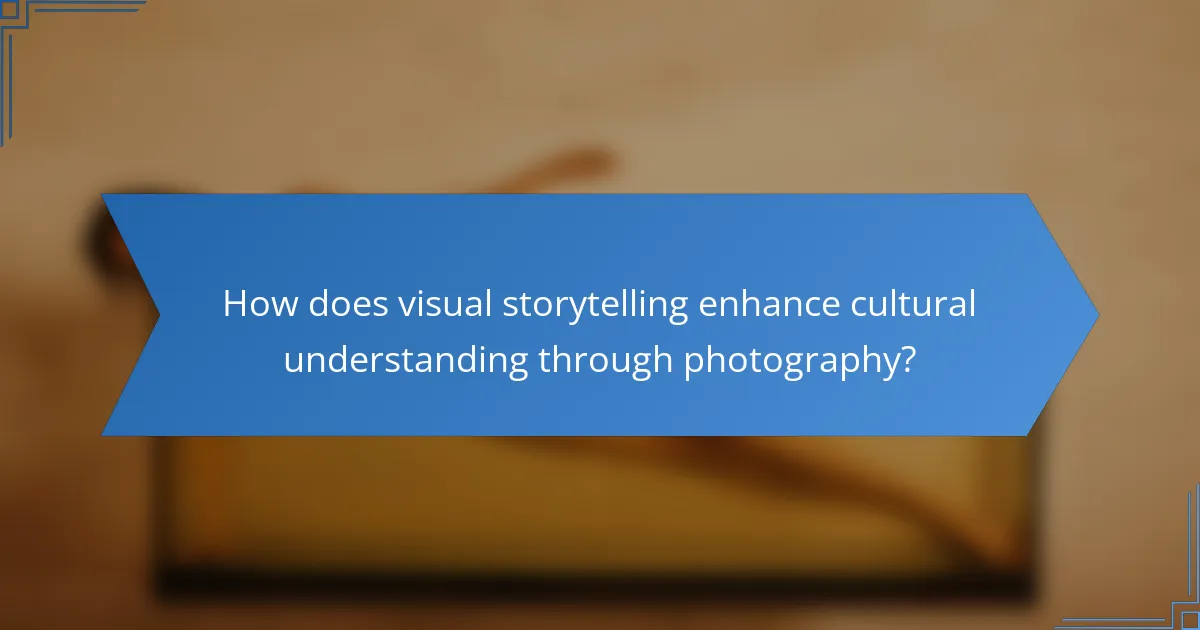
How does visual storytelling enhance cultural understanding through photography?
Visual storytelling enhances cultural understanding through photography by capturing authentic experiences and emotions. This visual medium transcends language barriers, allowing viewers to connect with diverse cultures on a personal level. Photographs convey intricate details about traditions, lifestyles, and social issues, fostering empathy and awareness. For example, a single image can encapsulate the essence of a community, highlighting unique attributes like traditional clothing or local festivals. As a result, photography serves as a powerful tool for cultural exchange, promoting appreciation and respect among different societies.
What role does composition play in conveying cultural narratives?
Composition plays a crucial role in conveying cultural narratives through visual storytelling. It shapes the viewer’s perception and emotional response. Effective composition highlights focal points, guiding the audience’s attention to cultural elements. Techniques like framing, balance, and colour use enhance the narrative’s depth. For instance, contrasting colours can signify cultural significance or emotional states. Additionally, unique compositional styles reflect specific cultural identities, making the visual story more relatable. Ultimately, composition is key in transforming photographs into powerful cultural experiences.
How can colour theory influence the perception of cultural stories?
Colour theory significantly influences the perception of cultural stories by evoking emotions and associations tied to specific colours. Different cultures attribute distinct meanings to colours, affecting how stories are interpreted. For example, red may symbolize passion in one culture but signify danger in another. This variability enriches visual storytelling in photography, allowing photographers to convey deeper cultural narratives through colour choices. Understanding these nuances enhances the emotional impact and relatability of cultural experiences depicted in visual media.
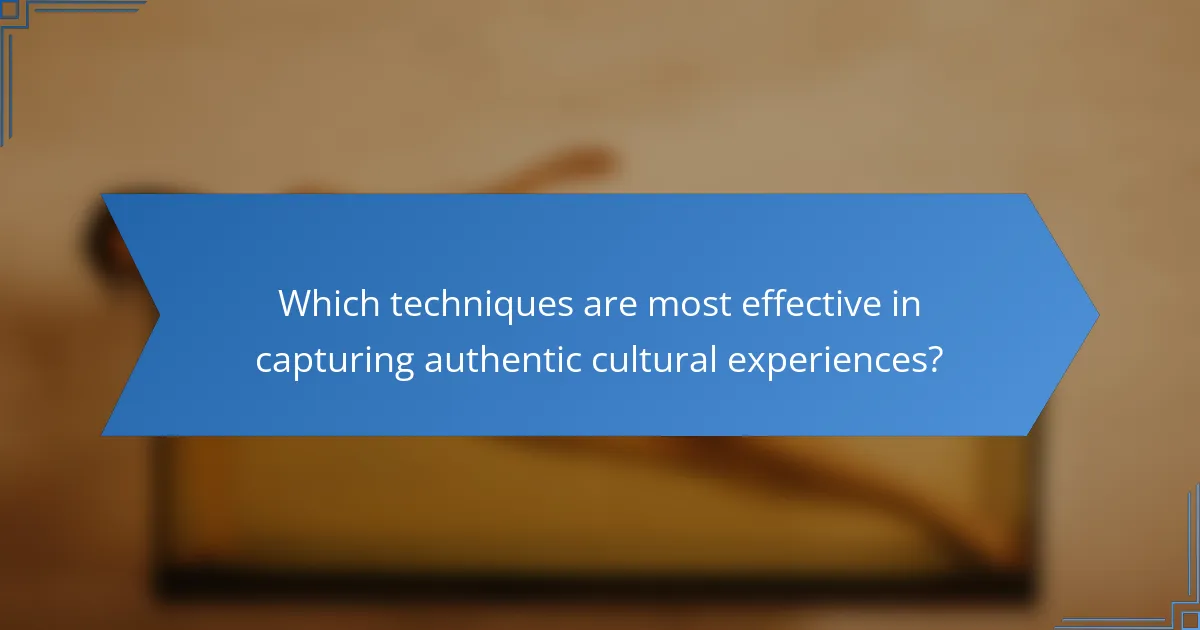
Which techniques are most effective in capturing authentic cultural experiences?
Visual storytelling through photography is highly effective in capturing authentic cultural experiences. Techniques such as candid shots, environmental portraits, and immersive compositions enhance the narrative, allowing viewers to connect emotionally.
Candid shots reveal genuine moments, showcasing cultural interactions without staging. Environmental portraits place subjects within their cultural context, providing insight into their lifestyles. Immersive compositions utilize depth and perspective, drawing viewers into the scene.
Additionally, using natural light enhances authenticity, while incorporating local elements and traditions enriches the storytelling. These techniques collectively foster a deeper understanding of diverse cultures.
How does the use of natural light impact cultural photography?
Natural light significantly enhances cultural photography by creating authentic atmospheres and highlighting textures. It captures the essence of cultural settings, revealing details that artificial lighting may obscure. The interplay of natural light with subjects can evoke emotions, telling deeper stories about traditions and practices. Furthermore, varying light conditions throughout the day offer unique opportunities to portray cultural experiences, enriching visual narratives.
What are the benefits of candid photography in storytelling?
Candid photography enhances storytelling by capturing authentic moments, revealing emotions, and fostering connection. It conveys cultural experiences through spontaneous interactions, showcasing the richness of daily life. This style often highlights unique attributes of subjects, making narratives more relatable and engaging. As a result, viewers gain deeper insights into diverse cultures and perspectives.
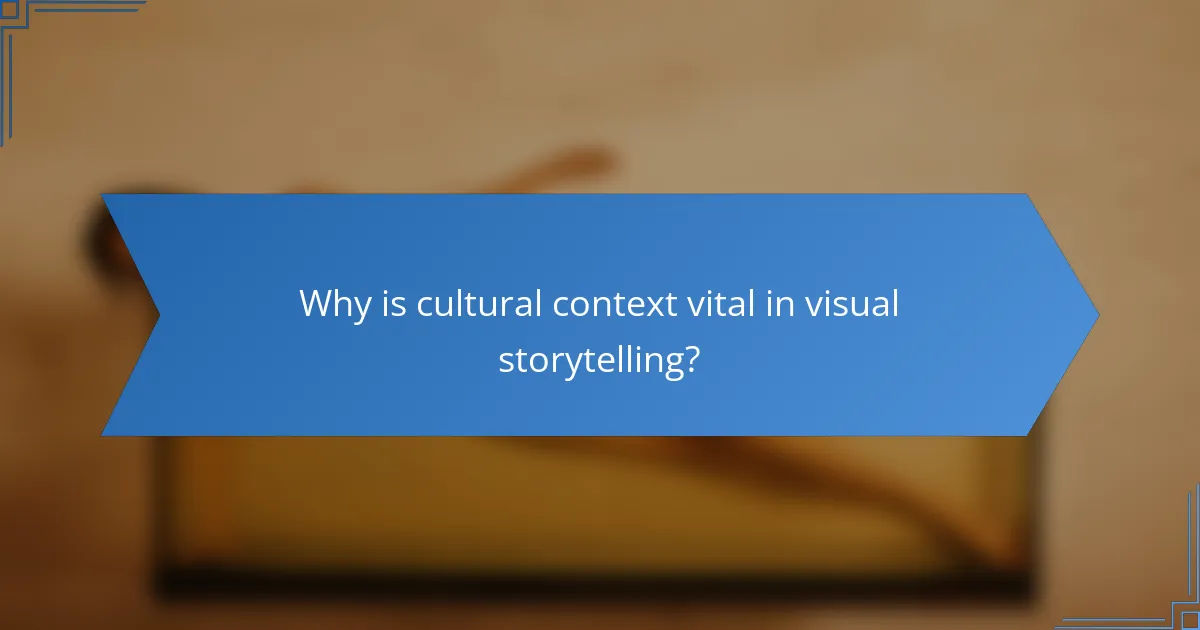
Why is cultural context vital in visual storytelling?
Cultural context is vital in visual storytelling because it shapes how audiences interpret images. Understanding cultural nuances allows photographers to convey deeper meanings and evoke emotions. This connection enhances the viewer’s experience and fosters empathy through shared cultural narratives. For instance, a photograph depicting a traditional festival can communicate values, beliefs, and social dynamics unique to that culture. By incorporating cultural context, visual storytelling becomes more impactful and resonates on a personal level, creating a bridge between diverse communities.
How do cultural symbols and motifs enrich photographic narratives?
Cultural symbols and motifs significantly enrich photographic narratives by adding depth and context. They evoke emotions and convey messages that resonate with viewers. Symbols, such as traditional attire or local architecture, reflect cultural identity and heritage. Motifs can illustrate themes like community, tradition, or transformation. This visual language fosters a connection between the subject and the audience, enhancing the storytelling experience. By integrating these elements, photographers can create compelling narratives that celebrate diversity and provoke thought.
What challenges do photographers face when representing diverse cultures?
Photographers face various challenges when representing diverse cultures, including misrepresentation, cultural sensitivity, and access. Misrepresentation occurs when photographers impose their perspectives, leading to stereotypes. Cultural sensitivity is crucial; understanding customs and traditions prevents offense. Access challenges arise in obtaining permission and building trust within communities. These factors can hinder authentic visual storytelling.
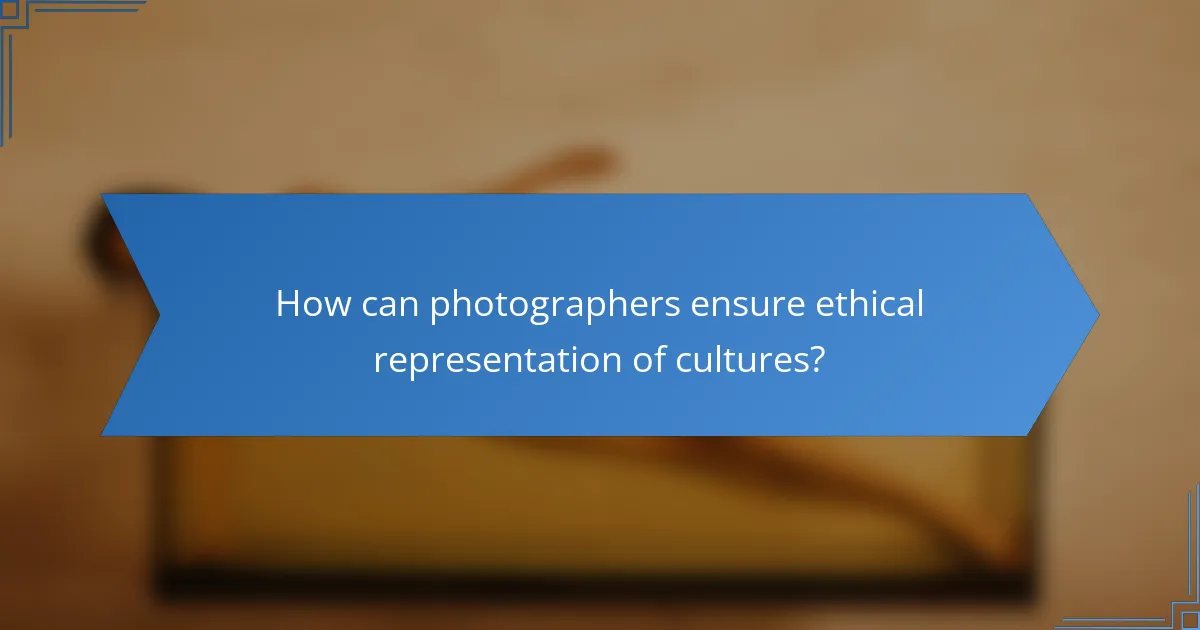
How can photographers ensure ethical representation of cultures?
Photographers can ensure ethical representation of cultures by prioritising authenticity and respect. They should engage with community members to gain insights and perspectives. This collaborative approach fosters trust and deepens understanding. Additionally, photographers must avoid stereotypes and misrepresentation by accurately portraying cultural nuances. They should focus on the stories and voices of individuals within the culture, ensuring diverse representation. Ethical practices include obtaining consent and being transparent about the purpose of the photography. This commitment to ethical representation enhances the integrity of visual storytelling while honouring the richness of cultural experiences.
What guidelines should be followed to respect cultural sensitivities?
To respect cultural sensitivities in visual storytelling, follow these guidelines: prioritise authentic representation, seek consent from subjects, and research cultural contexts. Understanding the cultural significance of symbols and practices enhances storytelling. Avoid stereotypes and generalisations, as they misrepresent cultures. Engage with local communities to gain insights and ensure respectful portrayal.
How can collaboration with local communities enhance storytelling?
Collaboration with local communities enhances storytelling by providing authentic perspectives and rich cultural insights. Engaging with community members allows photographers to capture genuine narratives that reflect local traditions and values. This collaboration fosters trust, leading to deeper connections and more impactful visual stories. By incorporating diverse voices, storytelling becomes more inclusive and resonates with broader audiences, showcasing unique attributes of each culture.
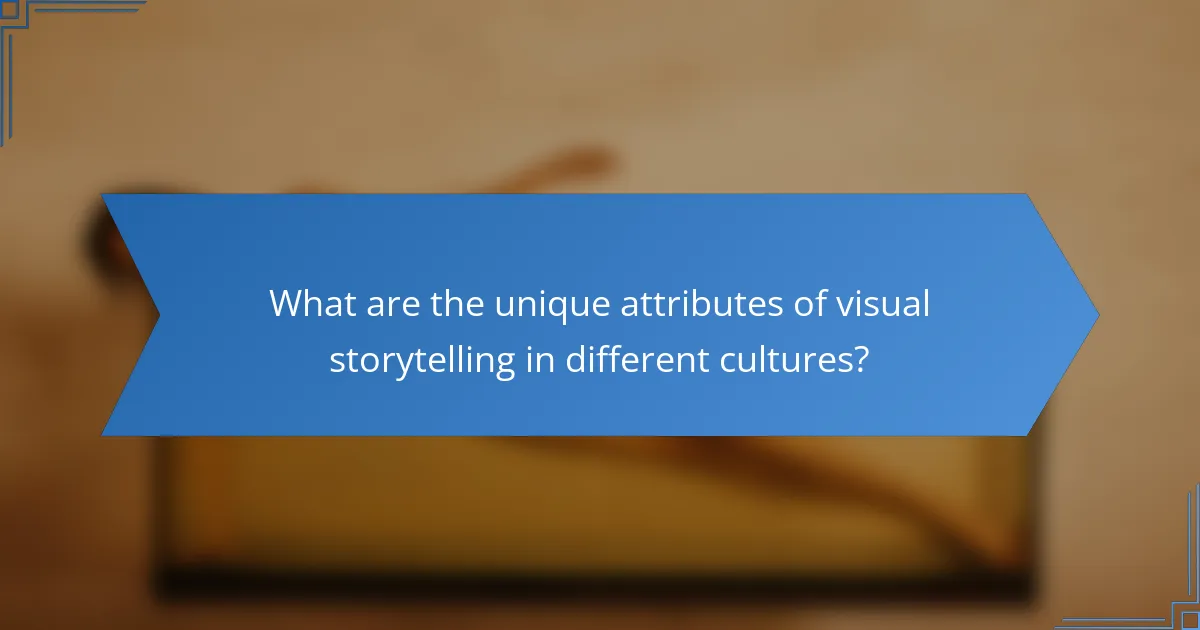
What are the unique attributes of visual storytelling in different cultures?
Visual storytelling varies significantly across cultures, showcasing unique attributes that reflect societal values. Cultural symbolism in imagery often conveys deeper meanings, emphasizing community, tradition, and identity. For instance, in Indigenous cultures, storytelling through photography may focus on nature and ancestral connections, while urban cultures might highlight modernity and diversity. Additionally, the use of colour and composition can differ, with some cultures favouring vibrant hues to evoke emotion, while others may prefer minimalistic approaches for clarity. These unique attributes enrich the narrative and deepen the viewer’s understanding of cultural experiences.
How does storytelling through photography vary across global regions?
Storytelling through photography varies significantly across global regions, influenced by cultural narratives and visual traditions. In Asia, photography often emphasizes harmony with nature, showcasing landscapes and spiritual elements. In Africa, vibrant colours and candid portraits reflect community life and resilience. European photography tends to focus on historical context, using architecture and urban scenes to tell stories of heritage. In North America, diverse styles highlight personal experiences and social issues, often aiming for emotional connection. Each region’s unique attributes shape how stories are conveyed visually, resulting in a rich tapestry of cultural expression.
Which cultural events provide rich opportunities for visual storytelling?
Cultural events that provide rich opportunities for visual storytelling include festivals, parades, art exhibitions, and traditional ceremonies. These events showcase diverse cultural expressions, allowing photographers to capture authentic moments. Festivals like Diwali or Carnival highlight vibrant colours and community spirit. Art exhibitions offer a glimpse into contemporary issues and cultural narratives. Traditional ceremonies, such as weddings or rites of passage, reveal deep-rooted customs and personal stories. Each event presents unique attributes that enhance visual storytelling through photography.
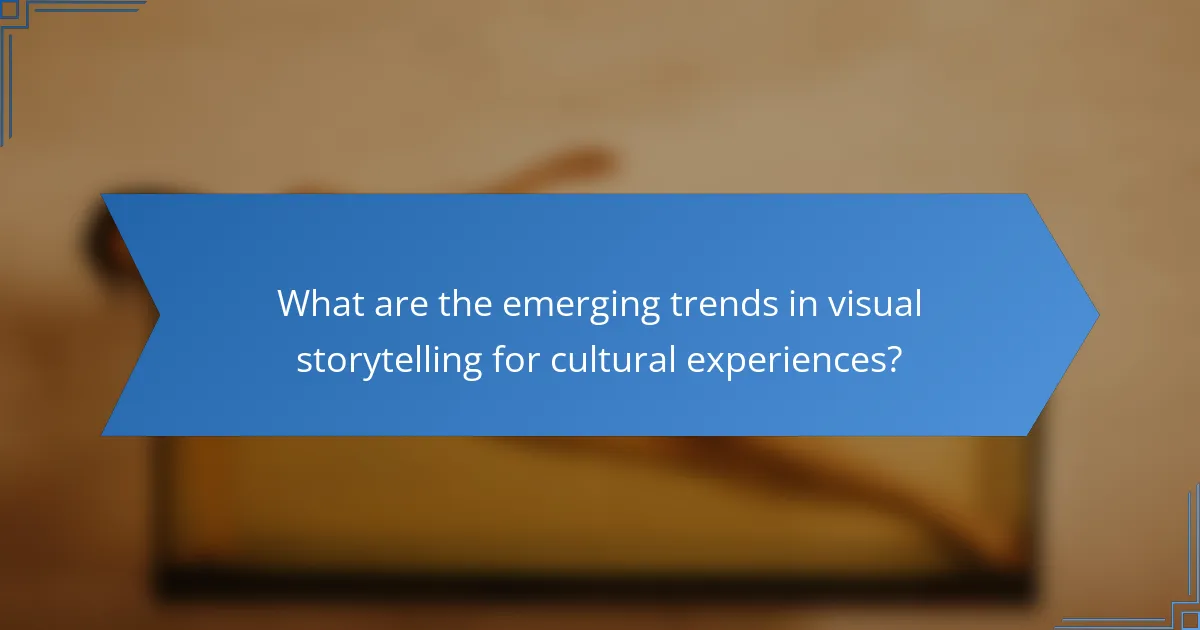
What are the emerging trends in visual storytelling for cultural experiences?
Emerging trends in visual storytelling for cultural experiences focus on immersive technologies and authentic narratives. These trends include the use of virtual reality to create engaging environments, interactive photography that invites audience participation, and the incorporation of diverse perspectives to reflect cultural richness. Additionally, social media platforms are shaping storytelling by promoting visual content that resonates with global audiences. As a result, visual storytelling is evolving to enhance cultural understanding and connection.
How is technology reshaping the way we share cultural narratives?
Technology is transforming visual storytelling by enhancing how cultural narratives are shared. Photography now utilises digital platforms, allowing diverse voices to present their experiences globally. This democratization enables photographers from various backgrounds to showcase unique cultural perspectives, enriching the narrative landscape.
Social media platforms amplify visual content, making it accessible to wider audiences. This shift fosters cultural exchange and understanding, as images can evoke emotions and provoke discussions around traditions, values, and identities.
Emerging technologies, such as augmented reality, further reshape storytelling by providing immersive experiences. These innovations allow viewers to engage with cultural narratives interactively, deepening their connection to the content.
In summary, technology enhances visual storytelling by broadening access, fostering cultural exchange, and enabling immersive experiences, ultimately reshaping how cultural narratives are shared and understood.
What role do social media platforms play in visual storytelling?
Social media platforms are vital for visual storytelling as they amplify cultural narratives through photography. They provide a global stage for diverse voices, enabling users to share and connect over visual content. Platforms like Instagram and Pinterest allow for the curation of cultural experiences, showcasing unique attributes of different societies. This visual engagement fosters community and understanding, as users interact with images that resonate on personal and cultural levels. Additionally, analytics tools on these platforms help storytellers gauge audience reactions, refining their narratives for greater impact.
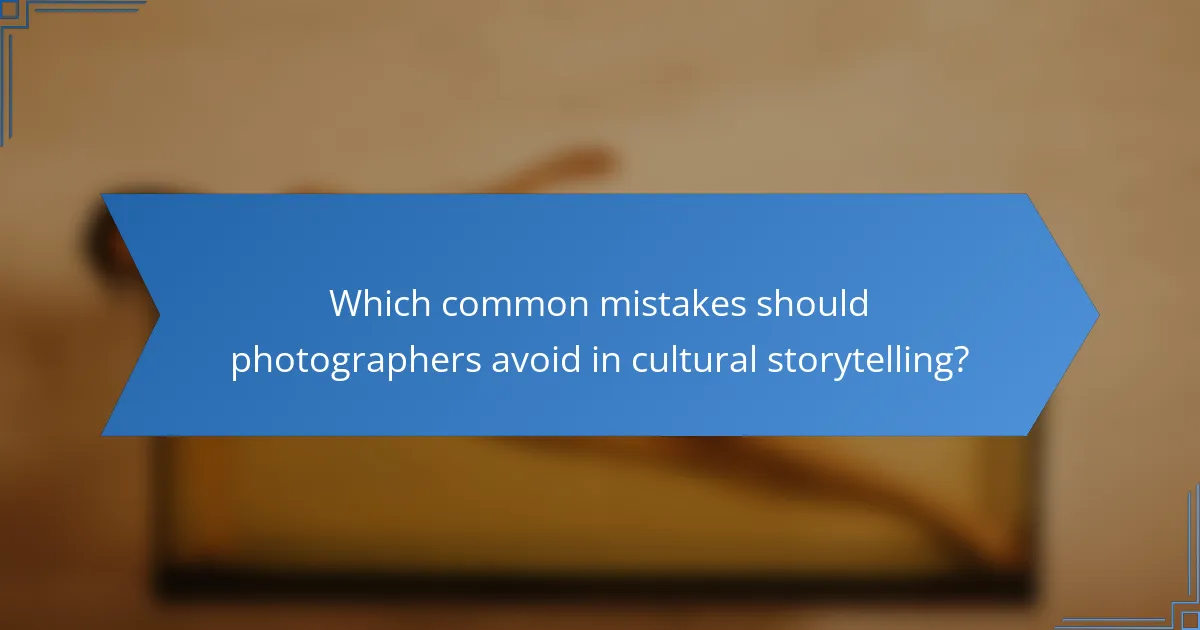
Which common mistakes should photographers avoid in cultural storytelling?
Photographers should avoid several common mistakes in cultural storytelling. Failing to research the culture can lead to misrepresentation. Ignoring the context of the subject may result in a lack of authenticity. Overlooking composition can diminish the visual impact of the story. Lastly, neglecting to connect emotionally with the audience reduces engagement.
What are best practices for capturing and sharing cultural experiences?
Visual storytelling through photography effectively captures and shares cultural experiences. Focus on authenticity, composition, and context to engage viewers.
1. Choose subjects that embody cultural significance.
2. Use natural lighting to enhance the atmosphere.
3. Capture candid moments to convey genuine emotions.
4. Incorporate local elements to provide context.
5. Edit thoughtfully to maintain the essence of the experience.
How can photographers improve their storytelling skills through feedback?
Photographers can enhance their storytelling skills by actively seeking and incorporating feedback. Constructive criticism helps identify strengths and weaknesses in visual narratives. Engaging with peers or mentors provides diverse perspectives that enrich storytelling techniques. This iterative process fosters growth and encourages experimentation with different cultural experiences, ultimately leading to more impactful photography.